
The model we encountered in the previous section, as you may quite clearly recall, was of a 2-dimensional universe that existed on the surface of a sphere. In material even a Flatlander could understand, what we in essence did was demonstrate how and why a 2-dimensional flying saucer on this spherical surface could travel in what it perceived to be a straight line, and yet end up where it started (as would happen on the surface of the earth). No matter how far the saucer travels (and no matter what direction it travels in) it will come across no boundary of any kind. The saucer, of course, never detects any curvature during the trip: to the saucer, everything appears flat - flat in the same way that the surface of the earth appears flat. What we learned in the previous section (which includes the 2 stack-diagram sequences of the flying saucer's paths around the sphere) is of major importance to us in that it is the means by which we can apply the topics just mentioned to the hypersphere.
 | |
How could we possibly travel in a straight line though space and end up where we started? Or travel through space as far as we can (and in any direction) and never reach an "outer edge"? The key to answering these questions lies in the procedure of bringing what we've learned in the previous section "up a notch" through the process of analogy. How would we envision a closed 3-dimensional surface (a surface that curves back on itself like a sphere, yet contains within itself 3 dimensions)? Displayed to the right is the model of the 3-dimensional hyperspherical universe we will be working with, in stack-diagram form. As you can see, our best conception of a closed 3-dimensional surface is as an array of closed 2-dimensional surfaces.
As a means of better understanding this, let us construct once again what is our best idea as to how we would directly experience the hypersphere: the 'compressed hypersphere'. The role, it would happen, that the 'compressed hypersphere' is about to take on here is very similar in nature to the role that the 'pressing together' of the slices of a sphere played in the previous section. 'Pressing together' slices, as you may recall, served the purpose of bringing about physical contact among slices separated by empty space. The purpose of "compressing" the hypersphere is similar: to allow the 2-dimensional spherical surfaces of the slices of the hypersphere to "overlap" and hence make contact. The first step, once again, in constructing the 'compressed hypersphere', is to imagine that each and every slice of the model of the hyperspherical universe is itself assigned to its own 3-dimensional plane, each 3-dimensional plane being spatially separate, lined up side by side. The next step, as you may recall, consists of imagining, as we've done before, these multiple 3-dimensional planes to occupy the space that we perceive our own 3-dimensional plane to take up. Because we have "compressed" several 3-dimensional planes worth of the slices of the hyperspherical universe onto a single 3-dimensional plane (as you may recall to have been performed in a previous section), the slices all end up "overlapping" on the plane onto which they were "compressed". This occurs because the slices are assuming the location they occupied on the plane they existed on before being "compressed" - a location, it would happen, that is the same for every slice. Upon having assumed the same location on the plane of the 'compressed hypersphere', we can further document the extent to which the slices relate to each other by taking note of the fact that the slices now share the same centerpoint. Now that the slices have been appropriately arranged, we will now be informed of the details as to how a closed 3-dimensional surface is formed.
How do the slices of a 'compressed hypersphere' "overlap"? Take note, firstly, that the spherical slices of the hypersphere we are dealing with are in fact hollow slices. Secondly, consider the notion that an "overlapping" of any 2 given slices of the 'compressed hypersphere' is to be considered valid only if the 2 slices were neighboring slices before being "compressed". The main factor, however, in determining whether any 2 given slices of the 'compressed hypersphere' "overlap", is the sizes of the slices themselves. This could be considered to take the form of the lengths of each slice's radius. If the radius of one spherical slice is too small or too large in relation to the radius of a second slice, the slices will not be close enough to "overlap". As a rule, neighboring slices will always be found to be able to overlap. When the lengths of radius of two 2-dimensional spherical surfaces are close enough, a common, shared area of intersection can be observed. This intersection exists in the form of a hollow, rounded spherical contour and is the equivalent of what we call "overlapping". We will call such an area a 'region of contact'. The 'region of contact' spoken of here is in every way similar to the 'regions of contact' spoken of in the previous section among the slices of the sphere. The 'region of contact', so to speak, that one would find among 2 neighboring slices of a 'pressed together' sphere, would be a hollow, rounded circle. The 'region of contact' that one would find among 2 neighboring slices of a "compressed" hypersphere, in turn, would be a hollow, rounded sphere. Though the elements involved in these relationships are one dimension apart in terms of hierarchy, in terms of concept the idea is exactly the same.
The hypersphere, it can be agreed, exists in our minds as an array of 3-dimensional slices. When relating those slices to each other, what we call the 'regions of contact' take on a special purpose. This purpose is to "unite" slices understood to be separate, into a single, connected greater structure. We know as a fact that there are no 2 neighboring slices of the hypersphere that do not "overlap". What this means, then, is that there are no 2 neighboring slices of the hypersphere that aren't linked together (by means of a 'region of contact'). In conclusion, we could state that there is no slice not linked to another slice. In effect, everything is connected. This allows what was introduced in the previous section as "communication" to occur across the slices of the hypersphere. Given what we know so far, we are to picture what we know to be the 2-dimensional spherical surfaces of each and every slice of the 'compressed hypersphere' to "combine" together into a single entity. Having pictured this, we are no longer to think of the slices of the hypersphere as individual, separate surfaces: this 'single entity' is in fact the single 3-dimensional surface of the hypersphere. Our best conception of a closed 3-dimensional surface, then, is as a "combining together" of an array of closed 2-dimensional surfaces.
If you have difficulty grasping the above material, think back to the previous section and recall the process of how the slices of the sphere "combined" to form the single 2-dimensional surface of the sphere. This act of "combining together" the slices of the sphere happens to be the very same process as the "combining together" of the slices of the 'compressed hypersphere' described in this section: all that differs between the 2 processes is their dimensional hierarchy. The process spoken of in the previous section involves the 1-dimensional surfaces of the slices of the sphere "combining" to form the 2-dimensional surface of the sphere. The process spoken of in this section is the same process, only now the slices "combining" together are the 2-dimensional surfaces of the slices of the hypersphere, and the surface formed by this union of slices is the 3-dimensional surface of the hypersphere. The concept of surfaces "overlapping" is an idea with which we have become quite familiar, it would happen, as it is the means by which we are able to envision a 3-dimensional surface. Take note, though, that when the slices of the hypersphere are in stack-diagram form, it is not possible to directly observe the 'regions of contact' among the slices, for the very reason that the slices are individually, separately lined up. It is for this reason that we must imagine the 'regions of contact' to occur amongst the slices of the stack-diagram, and in doing so allow "communication" across the slices to occur.
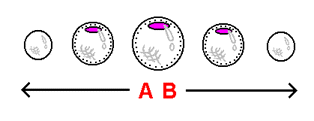 | |
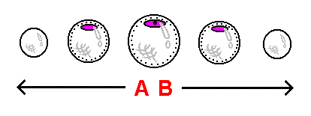 | |
How would we represent a 3-dimensional object on the surface of the hyperspherical universe we are working with? We will assume that floating about in the upper region of our 3-dimensional universe is a spaceship. Because the 3-dimensional surface we are working with is represented in the form of an array of 2-dimensional surfaces, all 3-dimensional objects on that surface, when represented in stack-diagram form, get "chopped up" into 2-dimensional cross-sections. In order to represent the spaceship in the stack-diagram, we must divide it into 2-dimensional cross-sections, and spread these cross-sections across the appropriate slices - as is done in the top stack-diagram on the left. The manner in which the slices increase and then decrease in size shows that the spaceship is rounded in shape. If we were to plot a point designating the precise location of the spaceship on the hyperspherical universe we are working with, it would be at a point located at the exact center of the spaceship (in the center of its central cross-section). Such a point is plotted in the bottom stack-diagram on the left. It is by means of this point that we will refer to the spaceship's location in the future. The purpose behind including the spaceship in the form of 2-dimensional cross-sections (and not just as a point) is to emphasize the fact that the spaceship, being a 3-dimensional object, possesses a distinct 'width' that spreads it across a given 3-dimensional region of the surface of the hyperspherical universe - a region of width that extends across multiple slices of the hypersphere, that a point by itself cannot portray.
How does a hypersphere close 3 dimensions? For any given region on the surface of a hypersphere there is at most 3 lines that can cross each other and lie at right angles to each other. These crossed lines represent the 3 dimensions of freedom that the spaceship has with which to move on the surface of the 3-dimensional universe. If we extended both ends of each line outward, they would follow a curved path until meeting on the other side of the hypersphere at the point exactly opposite to the point at which they originally met. These 3 closed loops represent the paths around the 3-dimensional universe that the spaceship could take given its 3 dimensions of freedom.
The illustrations among the next several paragraphs portray the spaceship travelling along these paths around the 3-dimensional hyperspherical universe we are working with. The 2 upper sequences portray paths around the hypersphere that are parallel to the alignment of the slices. The lower sequence portrays a path around this hypersphere that is perpendicular to the alignment of the slices. The paths parallel to the slices represent a form of closure that we are familiar with: the curvature of a sphere. The path perpendicular to the slices represents a form of closure that we are not familiar with: the curvature of a hypersphere. Clearly, we can grasp the closure of a sphere. The closure of a hypersphere, however, will be difficult to portray given the fact that we are limited to 3 dimensions. The sequences we have been speaking of, as you will see when you reach them, are arranged in a sequential, linear fashion. This format is reflected by the distinct 'frames' the sequences are divided into - each frame representing a separate instant in time in the execution of the sequence. Each individual frame itself, as you will see, consists of the array of slices that makes up the hypersphere.
The presence of the spaceship throughout the sequence is made known across the slices of the frames by means of what can be observed to be a point. In the parallel sequences, only one direction is involved in the process of execution (an order of passage that is designated by the numbers next to the frames). In the perpendicular sequence, however, the point can be found to leave a slice within a given frame, and later come back to that frame a second time, returning on a separate slice. As a means of portraying the distinct 3-dimensional 'width' that the spaceship possesses on the surface of the hypersphere (the width described earlier that involves multiple slices and that a point by itself cannot portray), the 2-dimensional cross-sections of the spaceship are displayed on the slices of all three sequences, appearing on and around the slice of the point designating the spaceship's location on the hypersphere.
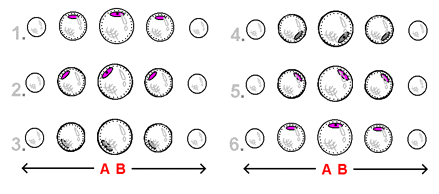 |
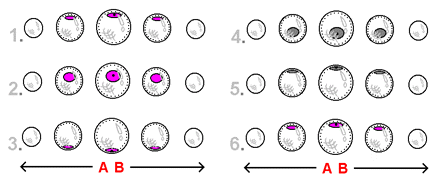 |
In all three sequences, the point representing the spaceship's location follows a circular path around the 3-dimensional hyperspherical universe. In the parallel sequences (that begin to be displayed to the right) the point completes the entire process without ever leaving the central slice of the hypersphere. The perpendicular sequence, however, that lies off-screen below, is more complex: though the point makes a trip to the bottom of the central slice and back as in the parallel sequences, the 2 half-circular trips performed involve a slice-to-slice progression around the slices that surround the central slice (rather than a trip confined entirely to the central slice itself). It is extension of the point into the slices that surround the central slice that represents curvature into the fourth dimension. This curvature, it would happen, is a direct result of the distinct increase and decrease in size that the inner hollow slices of the hypersphere undergo, in the process of extending from one small, solid outer slice to the other. Imagine, if you will, for the sake of study, the slices of a 'compressed hypersphere' to "combine" to form the single 3-dimensional surface of the hypersphere. It is the gradual waver in the sizes of the inner hollow slices just described that is responsible for the formation of the hyperspherical curvature that allows 3 dimensions to be closed.
In order to make the 2 half-circular trips involved in the perpendicular sequence easier to comprehend, certain 'mental aids' have been added to the sequence. First of all, the sequence is constructed so that the point's path across the stack-diagrams used in the sequence forms a distinct 'circular pattern'. This is an attempt to emphasize the concept of the curvature into the fourth dimension that the point engages in when following its circular path around the hypersphere - a curvature that, given that we are limited to 3 dimensions, can be difficult to express. Furthermore, all slices that the point crosses during the length of the sequence are highlighted. Finally, arrows have been added to the sequence that divide the point's circular trip around the hypersphere into the 2 distinct 'half-circular trips' described earlier. The arrows are to be used as a guide by which one envisions the slice-to-slice traversal of the point as it shifts across the layers of the sequence.
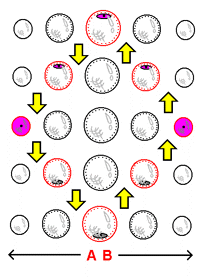 | |
The point's first half-circular trip of the perpendicular sequence (displayed to the right) is from the top to the bottom of the central slice. Imagine that the point at the top of the central slice is being 'pushed' downward in the direction of the arrows (toward the bottom of the central slice). The point "slides" onto the top of the next slice A-ward in response to being 'pushed' into the curvature of the half-circular path it is following. This process of 'pushing' and "sliding" is a 3-dimensional way to portray 4-dimensional curvature. After being 'pushed' downward once again the point "slides" A-ward and is 'pushed' directly downward through the spherical region of the small solid spherical slice, and upon reaching the bottom "slides" onto the bottom of the next slice B-ward. Finally, the point is 'pushed' in the direction of the arrows and "slides" B-ward, in effect returning to the central slice and completing the first 'half-circular trip' along the circular path around the hypersphere. For the second half-circular trip we are to picture the point to be pushed back upward (in the direction of the arrows) toward the area at which it started, making use of the same 'push and slide' process applied above. To give added meaning to the interaction among slices portrayed in the stack-diagrams just presented, try picturing the interaction among the slices as it would occur among the overlapping slices of the 'compressed hypersphere'. This is understandably difficult given that it would deal with slices that "overlap" (as opposed to the individually, separately lined up slices of the hypersphere as it exists in stack-diagram form). To perform such a feat, however, would perhaps be the closest we can come to directly experiencing the interaction that occurs amongst the slices of the actual hypersphere. The stack-diagrams in the 3 sequences just presented represent our basic conception of how a hypersphere closes 3 dimensions. In the next section we study how the structure of the hypersphere relates to how it is perceived.
| to previous section |
to table of contents |
to next section |
||
| Comments, questions, feedback: [email protected] |